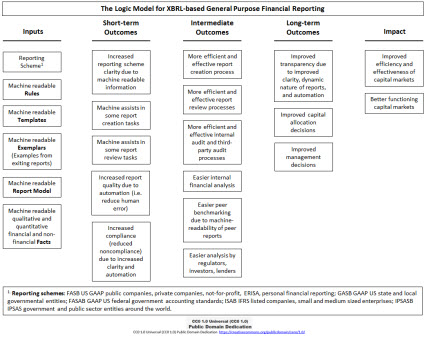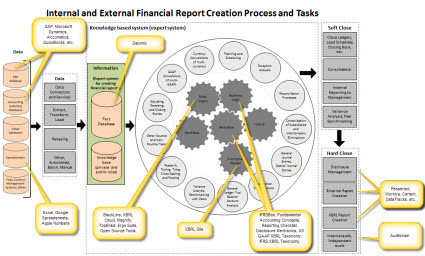Case for XBRL-based General Purpose Financial Reporting on One Slide
Financial reporting has a direct link to the well being of society. The world needs a digital alternative to the paper-based or "e-paper" general purpose financial report. The following is a summary for the case for XBRL-based general purpose financial reporting summarized on one slide:
(Click image for a larger view)
A general purpose financial report is a high-fidelity, high-resolution, high-quality information exchange mechanism. That mechanism has historically used the media of "paper". Over the past 50 years or so, that paper-based mechanism has given way to a new mechanism, "e-paper". By "e-paper" I mean PDF documents, HTML documents, Word documents and such.
XBRL is a new media, a new mechanism for creating a general purpose financial report. XBRL is a high-fidelity, high-resolution information exchange media that allows for the creation of high-quality financial reports. Those reports can be read by human-based processes as before but because of their structured nature are also effectively readable by machine-based processes.
And oh, XBRL is great for special purpose financial reports also.
If you don't understand how this would work, read Computer Empathy and maybe Financial Tansformation and the Modern Finance Platform. If you want to understand how to implement this, read Method of Implementing a Standard Digital Financial Report Using the XBRL Syntax and this step-by-step example of that method.
Here is a graphic that shows more details about the tasks involved in creating a financial report:
(Click image for larger view)
References (10)
-
 Response: Top 10 schools in jaipur
Response: Top 10 schools in jaipur -
 Response: Tere ashkon se mujh par
Response: Tere ashkon se mujh par -
 Response: Canola Oils manufacturers in India
Response: Canola Oils manufacturers in India -
 Response: event organisers in vijaywada
Response: event organisers in vijaywada -
 Response: CSBE Schools in Noida
Response: CSBE Schools in Noida -
 Response: Top Boarding School in India
Response: Top Boarding School in India -
 Response: Best Schools in Greater Noida West
Response: Best Schools in Greater Noida West -
 Response: graphic design course in delhi
Response: graphic design course in delhi -
 Response: www tndte gov in
Response: www tndte gov in -
 Response: Non Basmati Rice
Response: Non Basmati Rice



Reader Comments